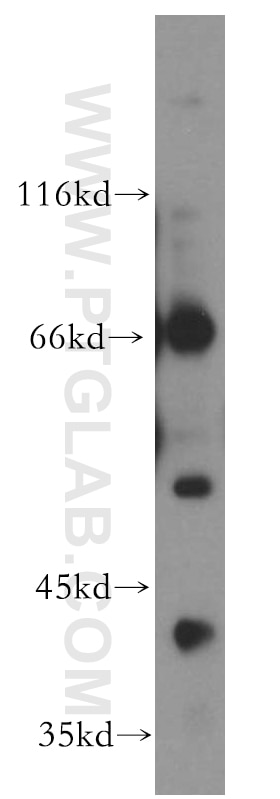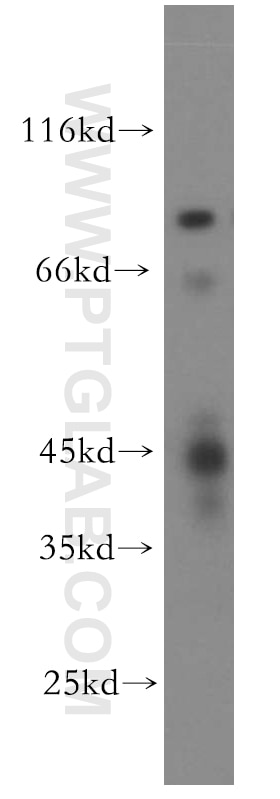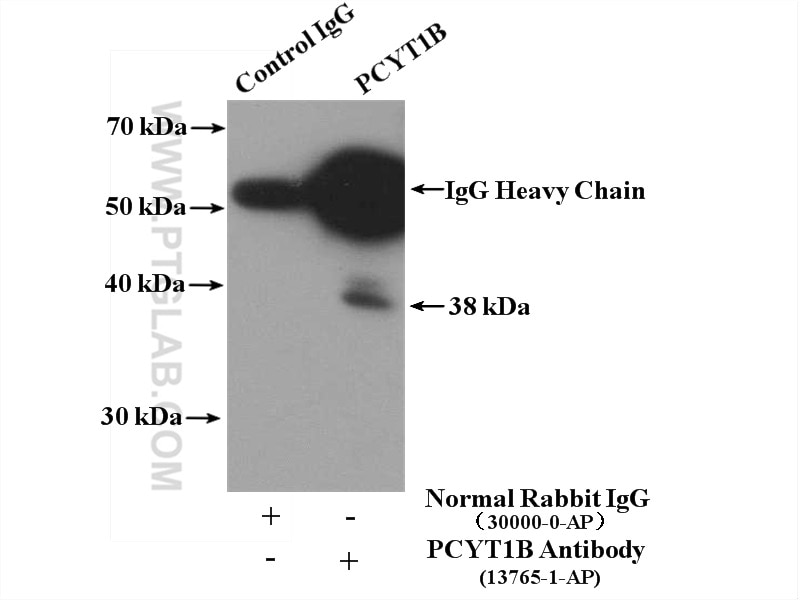Validation Data Gallery
Tested Applications
| Positive WB detected in | human placenta tissue, human brain tissue |
| Positive IP detected in | human placenta tissue |
Recommended dilution
| Application | Dilution |
|---|---|
| Western Blot (WB) | WB : 1:500-1:1000 |
| Immunoprecipitation (IP) | IP : 0.5-4.0 ug for 1.0-3.0 mg of total protein lysate |
| It is recommended that this reagent should be titrated in each testing system to obtain optimal results. | |
| Sample-dependent, Check data in validation data gallery. | |
Published Applications
| WB | See 1 publications below |
Product Information
13765-1-AP targets PCYT1B in WB, IP, ELISA applications and shows reactivity with human, mouse, rat samples.
| Tested Reactivity | human, mouse, rat |
| Cited Reactivity | mouse |
| Host / Isotype | Rabbit / IgG |
| Class | Polyclonal |
| Type | Antibody |
| Immunogen | PCYT1B fusion protein Ag4748 相同性解析による交差性が予測される生物種 |
| Full Name | phosphate cytidylyltransferase 1, choline, beta |
| Calculated molecular weight | 351 aa, 40 kDa |
| Observed molecular weight | 42 kDa |
| GenBank accession number | BC045634 |
| Gene Symbol | PCYT1B |
| Gene ID (NCBI) | 9468 |
| RRID | AB_10642953 |
| Conjugate | Unconjugated |
| Form | Liquid |
| Purification Method | Antigen affinity purification |
| UNIPROT ID | Q9Y5K3 |
| Storage Buffer | PBS with 0.02% sodium azide and 50% glycerol , pH 7.3 |
| Storage Conditions | Store at -20°C. Stable for one year after shipment. Aliquoting is unnecessary for -20oC storage. |
Background Information
PCYT1B (Phosphate Cytidylyltransferase 1B, Choline), also named as CTβ, CCTB and CCT-Beta, is encoded by the gene belongs to the cytidylyltransferase family. It is involved in the regulation of phosphatidylcholine biosynthesis. Several alternatively spliced transcript variants encoding different isoforms have been found for this gene. PCYT1B encodes three isoforms of CTβ (CTβ1, CTβ2 and CTβ3). CTβ1, CTβ2 isoforms are present in humans and CTβ2 and CTβ3 isoforms have been identified in mice. The CTβ2 can be detected as 41 kDa, and CTβ3 can be detected as 39 kDa.
Protocols
| Product Specific Protocols | |
|---|---|
| WB protocol for PCYT1B antibody 13765-1-AP | Download protocol |
| IP protocol for PCYT1B antibody 13765-1-AP | Download protocol |
| Standard Protocols | |
|---|---|
| Click here to view our Standard Protocols |
Publications
| Species | Application | Title |
|---|---|---|
Neurobiol Dis Choline metabolism in regulating inflammatory bowel disease-linked anxiety disorders: A multi-omics exploration of the gut-brain axis |


